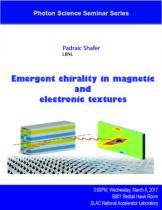Speaker: Padraic Shafer, LBNL
Program Description
Chirality determines many important properties in nature, ranging from the
electroweak interaction in particle physics to the reactions of enzymes that are
fundamental for life. In condensed matter physics, chiral structures determine the
functional behavior of magnetic and other correlated-electron materials. Underlying
these functionalities are a wealth of intriguing nanoscale ordering phenomena such
as charge, orbital, and spin superstructures, as well as periodic arrays of domains
and domains walls or vortices.
This talk focuses on the chiral nanostructures in two distinct material systems:
Chiral magnetic domain walls (DWs) in Co/Pt/Cu multilayers; and the emergent
chirality of electric polarization vortices in PbTiO3/SrTiO3 superlattices.
Our experimental measurements of DW chirality in ultrathin films are important
for both the fundamental understanding of DWs and in research on topologically
protected nanomagnetic structures [1]. Additionally, they provide critical
information for the development of DW-based spintronic devices, where DW
chirality has been suggested to greatly suppress the critical current density for
driving DW motion.
Recently we have discovered chiral topologies of electric polarization that are
reminiscent of rotational spin topologies. These nanometer-scale arrays of counterrotating
vortex pairs can be created by employing the competition between charge,
orbital, and lattice degrees of freedom in superlattices of alternating PbTiO3 and
SrTiO3 layers [2]. These observations have implications for the creation of new
states of matter (such as dipolar skyrmions, hedgehog states) and associated
phenomena in ferroic materials, such as electrically controllable chirality.
For both studies we employ the unique capabilities of resonant soft x-ray
diffraction (RSXD) as a tool for investigating electronic and magnetic
nanostructures. RSXD uses x-ray wavelengths of ~1‒3 nm that are well matched to
the periodicity of the nanostructures. By selecting wavelengths that correspond to
resonant electronic transitions we gain sensitivity to probe the magnetic or electric
polarization orientations. In particular, x-ray circular dichroism (XCD)—the
difference in diffraction intensity when circularly polarized x-rays of opposite
helicity are used—is central to identifying chiral polarization textures that emerge
in magnetic domain walls and in vortex superlattices composed of non-chiral
constituents.
[1] G. Chen et al., Nature Communications 4, 2671 (2013).
[2] A. K. Yadav et al., Nature 530, 198 (2016).
Biography
Padraic Shafer is a Research Scientist at the Advanced Light Source, an x-ray
synchrotron facility at Lawrence Berkeley National Laboratory. He received a Ph.D.
in Materials Science and Engineering from the University of California, Berkeley for
work on nanoscale ferroelectric domains and vibrational energy scavenging. As a
Postoctoral Research Fellow at the ALS, Padraic designed and commissioned a
beamline endstation for resonant x-ray scattering studies of strongly correlated
electronic materials. He joined the Magnetic Spectroscopy and Scattering Group as
an ALS scientist in 2012. Previously he was a research and development engineer at
the Microelectronics Division of IBM, after receiving a B.S. from the University of
Illinois at Urbana-Champaign.
Padraic studies electronic order at domain walls and thin film interfaces in complex
oxides and magnetic metals using a combination of resonant soft x-ray absorption
and scattering. He also investigates spin-pumped dynamics in magnetic multilayers
using x-ray based ferromagnetic resonance.





